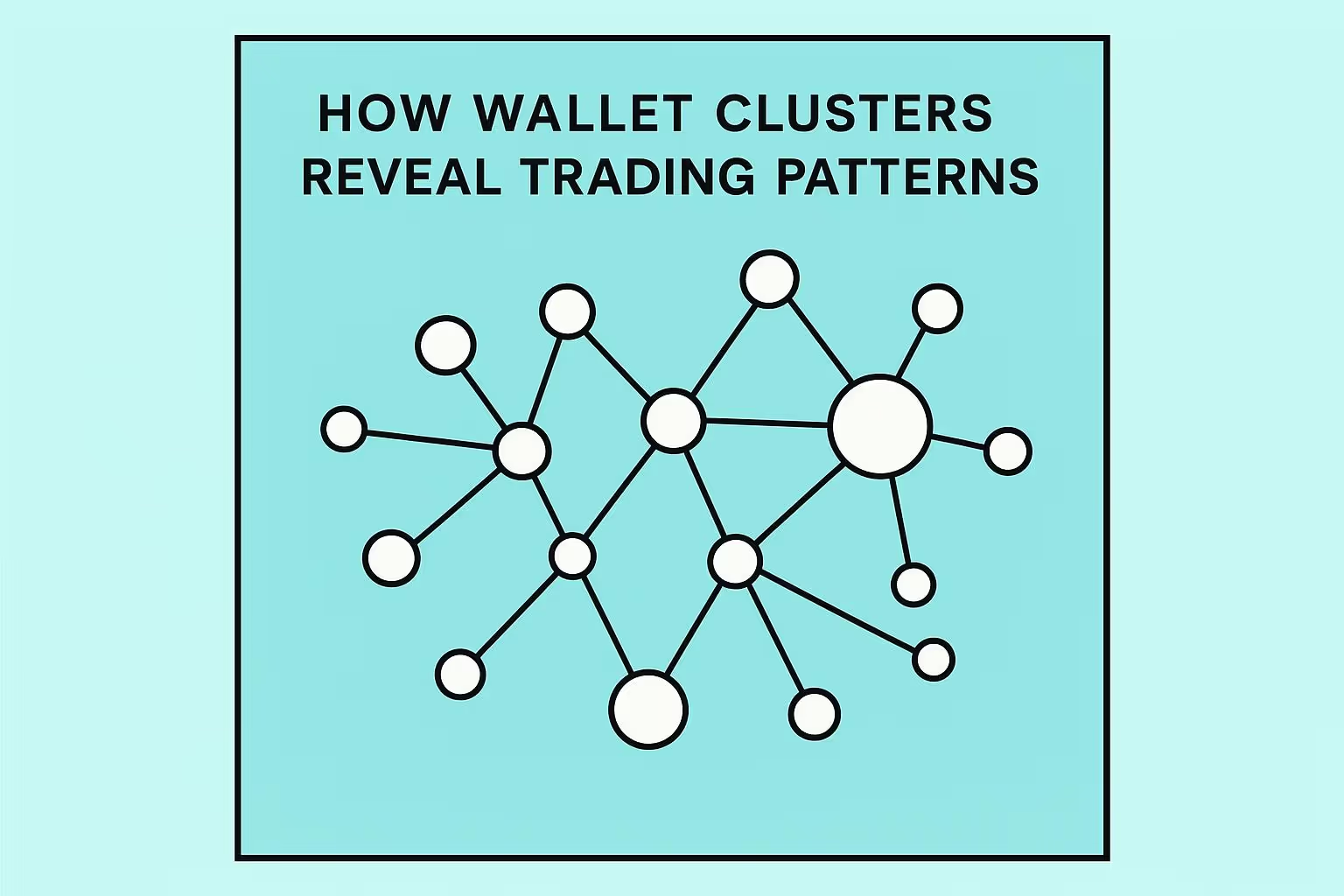Find Your Crypto Wallet Address: A Guide
how to find crypto wallet address: Discover exact steps to locate your address on MetaMask, Coinbase, Trust Wallet, and more, with tips to stay safe.

December 14, 2025
Wallet Finder

November 19, 2025

Wallet clustering is a way to group blockchain wallets based on how they behave. By analyzing transaction patterns, traders and analysts can find trading strategies, track big players, and spot trends. This helps manage risks and make smarter decisions in the fast-changing crypto market. Here's what you need to know:
Understanding wallet clusters turns blockchain data into actionable insights, making trading decisions more data-driven and transparent.

Getting access to reliable blockchain data is the starting point for successful wallet clustering analysis. The blockchain holds a massive amount of information, but it’s scattered and unorganized. The first step in blockchain analysis is accessing transaction data. Once you’ve got the data, the next challenge is organizing it in a way that works for clustering analysis.
At its core,
is the practice of extracting meaning from decentralized transaction records. It's part forensic accounting, part behavioral analysis, part infrastructure monitoring.
This highlights why properly extracting and preparing data is so important for traders aiming to uncover profitable trends.
Before you start collecting data, it’s essential to define a clear question and narrow the scope by specifying the blockchain, time period, and event types. For instance, you could focus on Ethereum transactions between January 1, 2024, and March 31, 2024, targeting DEX trades above $10,000. This helps keep your analysis focused and manageable.
There are several ways to gather blockchain data:
Once you’ve collected the raw data, the next step is to clean and organize it for analysis.
Raw blockchain data can be chaotic. Even though blockchain data is public, it requires cleaning, normalization, and structuring to make it usable. For example, transaction amounts may have inconsistent decimal places, addresses could appear in multiple formats, and timestamps often need to be standardized.
Here’s how to clean and organize the data:
Modern tools can automate much of this process. For example, Mammoth Analytics offers automated data cleaning with AI-powered anomaly detection, while CleanSwift Pro features pattern recognition for data standardization.
For crypto-specific challenges, specialized software can make a big difference. Traditional ERP systems aren’t built to handle crypto transactions, making manual recording tedious and error-prone. Tools like SoftLedger excel at real-time financial data processing, and CoinLedger simplifies transaction categorization.
To take your data a step further, enrich it with external labels. Add wallet labels (like exchange, DeFi protocol, or known trader), token classifications (such as stablecoin or governance token), and transaction types (swap, liquidity provision, arbitrage). This enrichment turns raw data into actionable insights, revealing trading patterns and wallet connections.
This refined dataset sets the stage for applying clustering algorithms to uncover trading behaviors in the next steps.
When data is well-organized, grouping wallets by behavior becomes much more effective. Today, machine learning plays a key role in identifying behavioral patterns in wallets, uncovering trading habits that manual analysis might overlook.
"We believe wallets should be understood through dynamic behavior, not static identity. Instead of assigning fixed labels to addresses, we analyze the patterns, habits, and decisions reflected in on-chain activity." – Oracul Analytics
This approach shifts the focus from static labels to dynamic behavior, giving traders a stronger tool to spot profitable patterns.
Transaction frequency and trade volume are key indicators for understanding wallet behavior. Rather than focusing on wallet ownership, the analysis emphasizes operational patterns. With the Bitcoin network processing over 300,000 transactions daily and Ethereum exceeding 1 billion total transactions, there’s a wealth of data to examine. Managing these activities efficiently also means keeping an eye on costs, which is why learning about Ethereum gas fees and how to save on short-term trades can make a significant difference for active traders.
Behavioral clustering looks at several key factors:
Modern tools, like Graph Attention Networks (GATs), take this data and group wallets based on their unique behavioral patterns and interactions. These systems generate "behavioral fingerprints" for each wallet, making clustering more precise.
Once behavior clusters are identified, wallets can be classified to uncover distinct trading styles.
Wallets can be classified by factors like transaction frequency, trade volume, protocol diversity, and capital flows. This classification helps traders fine-tune their strategies. Advanced techniques, such as zero-shot classification, can even detect new patterns by comparing wallet behaviors to pre-defined prototypes. One study showed this method's accuracy, achieving 99.17% precision, 99.83% recall, and a 99.50% F1-score when inferring identities using transaction sub-graphs.

Wallet Finder.ai simplifies wallet clustering and strategy development with cutting-edge tools. These features integrate advanced clustering techniques, making analysis more intuitive for users.
Here’s how Wallet Finder.ai helps:
With these tools, Wallet Finder.ai makes it easier to identify, analyze, and act on wallet clusters, giving traders a sharper edge in their decision-making.
Once wallet clusters are identified, the next step is to dig into their behavior to uncover actionable trading insights. Every transaction leaves behind a trail, creating a clear picture of activity over time. This level of transparency gives traders access to market intelligence that was once hard to come by.
Wallet clusters can reveal a lot about trading strategies, timing preferences, and risk management techniques. By studying transaction patterns within these clusters, traders can differentiate between various types of market participants and their approaches.
Using graph-based clustering, wallets are grouped by shared transaction behaviors. This method can identify institutional trading patterns, uncover connections between wallets, and track large transfers. These insights help traders understand liquidity flows and institutional strategies. AI tools take this a step further by classifying wallets in real time, analyzing capital movements, and identifying trends like long-term holding, high-frequency trading, arbitrage, fund rotations, and even potential manipulation.
For instance, an analysis of wallet 0x41Bc7d0687e6Cea57Fa26da78379DfDC5627C56d showed $400,000 in Blockchain-certified Data Tokens and $325,320 in ether.fi governance tokens. This points to strategies focused on yield farming, liquidity provision, and staking.
These behavioral patterns pave the way for deeper, quantitative comparisons that can sharpen trading strategies.
Building on observed behaviors, traders can measure cluster performance using key metrics. Metrics like transaction volume, active addresses, total value locked (TVL), MVRV, and NVT ratios provide insights into trading styles and performance. For example, average transaction size and holding periods can highlight whether a cluster prefers frequent, small trades or larger, less frequent ones.
Monitoring whale wallets is particularly valuable. As of June 17, 2025, just four addresses hold 100,000 or more BTC, worth a combined $66 billion. Watching these wallets for movements to centralized exchanges can signal potential sell-offs. Similarly, tracking exchange inflows and outflows can hint at market trends - large inflows may indicate selling pressure, while outflows could suggest accumulation. In the 2021 bull run, for example, ETH outflows increased as users locked tokens into DeFi protocols, creating price support. However, traders should remain cautious, as some actors may deliberately mislead on-chain analysis.
To make sense of all this data, tools like Wallet Finder.ai provide powerful visualization options. This platform helps DeFi traders by offering detailed dashboards that showcase wallet profitability, token performance, and trading activity.
Features include dynamic charts, real-time wallet scanning, and customizable watchlists with Telegram alerts for quick action. Traders can filter data to focus on metrics that align with their strategies. For more in-depth analysis, Wallet Finder.ai allows data exports for offline review and smart-contract evaluations, helping traders assess token risks and avoid scams.
Once you've analyzed wallet clusters and identified behavioral patterns, the next step is turning those insights into actionable trading strategies. Wallet cluster analysis not only highlights market trends but also helps traders adapt their strategies as conditions change. This process transforms raw data into practical trading decisions.
One of the smartest ways to refine your trading approach is to study successful patterns and steer clear of behaviors linked to losses. By identifying clusters with similar trading traits, you can assess which strategies thrive under different market conditions. For instance, if a cluster consistently performs well during volatile periods by maintaining smaller position sizes, it may highlight strong risk management practices. Conversely, clusters with poor results can reveal tactics to avoid.
Institutional clusters are another valuable resource, often signaling emerging trends. Instead of mimicking exact trades, focus on repeatable behaviors like position sizing, diversification, holding periods, and risk management techniques. These patterns, tailored to your capital and risk tolerance, can enhance your strategy. Such insights pair well with earlier methods for managing risk.
Static analysis has its limits. Real-time monitoring of wallet clusters provides the timing edge needed to act on market opportunities as they arise. Once your strategy is refined, real-time alerts ensure you stay ahead of the curve.
"Understanding wallet relationships is crucial for monitoring institutional movements, detecting illicit activities, identifying whale trades, and mapping out liquidity flows in decentralized finance (DeFi)." - Reade D. Edwardson
Real-time alerts let traders anticipate shifts and respond quickly. For example, if a high-performing wallet cluster suddenly increases activity in a specific token or protocol, it could signal an opportunity - or a risk - that hasn’t yet impacted market prices.
Wallet Finder.ai’s real-time alert system integrates with Telegram, delivering instant notifications when monitored clusters make significant moves. These alerts track triggers like large wallet transfers, spikes in trading activity, or changes in asset flow.
Dynamic hedging strategies also benefit from real-time cluster insights. Instead of relying solely on traditional indicators, traders can adjust risk exposure based on the actions of successful wallet clusters. Wallet Finder.ai’s custom watchlist feature allows users to focus on the most relevant clusters, cutting through the noise while ensuring critical signals are captured.
Wallet clustering simplifies the overwhelming complexity of blockchain data by grouping addresses with similar behaviors. This approach uncovers patterns like accumulation, distribution, and coordinated trading - often signaling potential price movements.
Take the October 2020 Bitcoin rally, for example. Wallet clustering revealed large-scale outflows from exchanges to cold storage by major entities, a trend that came just before a prolonged price surge.
Another major benefit is reducing risks. Clustering can detect subtle warning signs, such as synchronized inflows or withdrawals, that might go unnoticed with individual analysis. These signals often appear before key market shifts. In May 2025, Bubblemaps identified identical wallet behaviors and shared funding sources across several crypto projects, hinting at possible coordinated activity.
Among the top 20 cryptocurrencies, data shows that 14 consistently align with clustering strategies. This enables traders to better understand how assets interact, helping them build more resilient portfolios.
Tools like Wallet Finder.ai take this a step further by automating the process. With real-time tracking, performance analysis, and customizable alerts, users can transform raw blockchain data into actionable insights. The platform allows traders to filter data, export findings, and even benchmark their performance against top-performing clusters. This is especially important given the enormous scale of modern DeFi transactions.
For instance, one wallet received nearly $1.6 million in swETH derivative tokens from two addresses within just 24 hours. Tracking such high-volume transactions manually would be nearly impossible, but clustering tools make these patterns clear and actionable.
Ultimately, wallet clustering moves cryptocurrency trading from guesswork to strategy. By relying on concrete blockchain behavior, it brings transparency and data-driven decision-making to the forefront of the crypto space.
Understanding wallet clusters can play a big role in improving trading strategies and managing risks. By studying groups of wallets that trade or interact in similar ways, traders can uncover patterns that reveal trends, predict major market movements, and even spot risks like potential market manipulation.
This kind of analysis gives traders the tools to make smarter decisions, avoid unnecessary losses, and boost profits. It also helps reduce the impact of sudden market changes, making it easier to assess risks and plan strategies more effectively.
Cleaning and organizing blockchain data for wallet clustering is no small task. The massive amount of transaction data, combined with its complexity, means you have to carefully filter out irrelevant details while keeping the useful bits intact. On top of that, blockchain records can be all over the place - fragmented and in different formats - which makes grouping related wallets a tricky process.
Another big challenge is balancing data accuracy with user privacy. To make sense of the data, advanced cleaning methods and solid management systems are essential to tackle these issues. When done right, this effort can reveal valuable insights and highlight profitable trends in blockchain activity.
Traders can use wallet clustering alerts to keep up with market trends by getting real-time updates on major wallet activities. These updates might include large fund transfers or unusual transaction patterns. Such alerts can point to important market shifts, like whale transactions or coordinated wallet movements, giving traders a chance to act quickly on potential opportunities or risks.
By responding to these insights right away, traders can navigate volatile markets more effectively, reduce risks, and spot profitable trading patterns. Tools like Wallet Finder.ai simplify the process by tracking wallet performance, analyzing trading behavior, and delivering timely updates to help traders stay ahead.
{"@context":"https://schema.org","@type":"FAQPage","mainEntity":[{"@type":"Question","name":"How can identifying wallet clusters improve trading strategies and risk management in crypto?","acceptedAnswer":{"@type":"Answer","text":"<p>Understanding wallet clusters can play a big role in improving trading strategies and managing risks. By studying groups of wallets that trade or interact in similar ways, traders can uncover patterns that reveal trends, predict major market movements, and even spot risks like potential market manipulation.</p> <p>This kind of analysis gives traders the tools to make smarter decisions, avoid unnecessary losses, and boost profits. It also helps reduce the impact of sudden market changes, making it easier to assess risks and plan strategies more effectively.</p>"}},{"@type":"Question","name":"What challenges arise when cleaning and organizing blockchain data for wallet clustering?","acceptedAnswer":{"@type":"Answer","text":"<p>Cleaning and organizing blockchain data for wallet clustering is no small task. The massive amount of transaction data, combined with its complexity, means you have to carefully filter out irrelevant details while keeping the useful bits intact. On top of that, blockchain records can be all over the place - fragmented and in different formats - which makes grouping related wallets a tricky process.</p> <p>Another big challenge is balancing data accuracy with user privacy. To make sense of the data, advanced cleaning methods and solid management systems are essential to tackle these issues. When done right, this effort can reveal valuable insights and highlight profitable trends in blockchain activity.</p>"}},{"@type":"Question","name":"How can traders use wallet clustering alerts to spot and act on market opportunities?","acceptedAnswer":{"@type":"Answer","text":"<p>Traders can use <strong>wallet clustering alerts</strong> to keep up with market trends by getting real-time updates on major <a href=\"https://www.walletfinder.ai/plans/basic-plan\">wallet activities</a>. These updates might include large fund transfers or unusual transaction patterns. Such alerts can point to important market shifts, like whale transactions or coordinated wallet movements, giving traders a chance to act quickly on potential opportunities or risks.</p> <p>By responding to these insights right away, traders can navigate volatile markets more effectively, reduce risks, and spot profitable trading patterns. Tools like <strong>Wallet Finder.ai</strong> simplify the process by tracking wallet performance, analyzing trading behavior, and delivering timely updates to help traders stay ahead.</p>"}}]}
"I've tried the beta version of Walletfinder.ai extensively and I was blown away by how you can filter through the data, and the massive profitable wallets available in the filter presets, unbelievably valuable for any trader or copy trader. This is unfair advantage."
.avif)
Pablo Massa
Experienced DeFi Trader